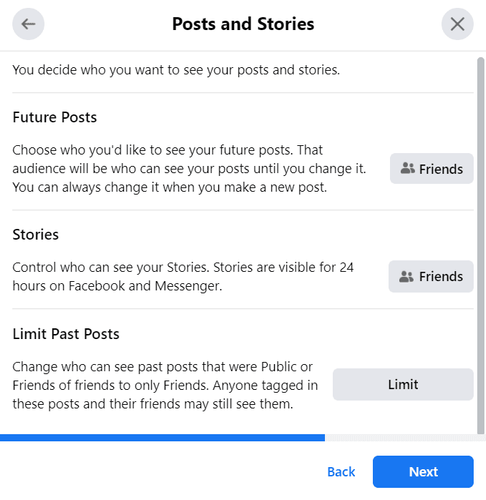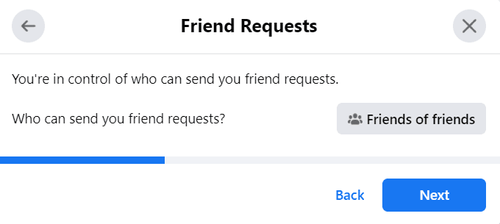
Jerry Wiggins
Last updated:Nov 23, 2023
Facebook parental settings are the essential way to keep your children secure when using the social media platform. Many children are lying about their age to register on Facebook, despite the fact that the social media platform was initially designed exclusively for adults and that minors are not permitted to have their own account until the age of 13. However, why are age limitations in place? Children are not yet able to fully accept responsibility for their acts or determine what is good or bad for them.
Social media can pose a serious risk to your child’s security. Your child can wait for the excessive information sharing, stranger contacts, attachment to undesired content, fake news, cyberbullying, sexual harassment, theft of personal data, and data harvesting on social media. It’s recommended by experts to introduce your children to social media as late as possible. It’s appropriate when you believe your child is prepared to face every threat.
Facebook Messenger Kids is a kid-focused app that was released in 2017. With the help of this programme, parents will have better control over social media and the problem of younger children using Facebook will be resolved. The children’s version lets you manage important activities and has parental restrictions.
How to Put Parental Controls on Facebook and Block Someone on Messenger?
You are able to impose some limitations on your child’s Facebook account. Yes, they assist you in avoiding any unfortunate events and cover the essential activities, but they still fall short of providing total protection. Among the limitations that Facebook may impose, you can:
- Restrict chatting functions
- Block inappropriate content
- Prevent identity theft
- Limit social interaction
How to Set Up Facebook Parental Controls?
You must first gain access to your child’s account in order to enable Facebook Parental controls. Click on Privacy check-up under Settings and Privacy after you’ve reached the account’s settings page.

In just three simple steps, you can easily set up parental restrictions for your child’s account using the Privacy Checkup tool. Selecting who can view your child’s postings and fresh content is the first step. To ensure that strangers cannot access this information, make sure you choose “Friends.”

You must first gain access to your child’s account in order to enable Facebook Parental controls. Click on Privacy check-up under Settings and Privacy after you’ve reached the account’s settings page.
You can add more individuals to the prohibited list by following additional instructions. There may be circumstances in which you would prefer that your child not interact with certain individuals.

Controlling who can add friends to your child on Facebook is another helpful setting you can apply to their account. Limit unwanted encounters by setting it to friends of friends.

If you are an iPhone, iPad, and Mac user, you can click to jump Apple's built-in parental control function for more understanding
Why Do You Need It?
An essential component of child guidance is digital parental control. For most children these days, the internet is an integral part of their lives. It is your responsibility as a parent to ensure that your child uses technology safely. It’s crucial to let your children know that you have parental control over their internet behaviour. Tell them about the dangers of social media use and the reasons behind your activity restrictions. Your children should be aware of every risk concealed by seemingly good deeds. This will assist you in building a connection of trust with your kids.
Try to teach your children about online safety before they get their first social media accounts. They should be aware that they should only communicate with people they know on the internet. Additionally, keep in mind that there are unpleasant and vicious people on social media sometimes. No matter how carefully you monitor your children’s internet behaviour, you will never be able to completely stop bad things from happening. Now, let’s discuss the main justifications for utilising parental control on your children’s social media accounts.
Protecting from Potential Harm
You are the one who shields your child from possible harm while they are too little. Since you will always be there to protect them, it is imperative that you teach your child how to defend themselves online. Naturally, you will progressively teach your child all of these skills as you begin to introduce them to the internet. Educating your child about the potential risks of the internet—such as abuse, sexting, cyberbullying, theft of personal information, and much more—is the first thing you can do.
After your child understands the proper usage of social media, you can go to the next phase, which is setting up parental controls. If your child is too young to take responsibility for their behaviour, you should implement this step. Parental control is a tool that lets parents supervise their children’s online activity and shield them from harm. Facebook parental controls let you monitor what people do online, block things that you don’t want them to see, and moderate conversations. You can access far more data than just social media with specialised tracking software, shielding your child from online dangers and dubious individuals.
Informational Security
When parental controls are enabled, there is very little chance of personal data leaks. This is because a child’s account has family membership characteristics and is primarily secured by an adult account. However, it is also quite simple for cybercriminals to obtain all the information they require from your kid. Children frequently become victims of invasions of privacy because they lack the expertise necessary to fight back. Online scammers target children and have easy access to manipulate them. Instruct your child on the need of keeping their personal information private and the fundamental ways to secure it. What basic knowledge about information security can you impart to your child?
· Begin as quickly as possible. It’s time to have a conversation with your child about safe gadget use once they can operate a computer or any other device.
· Keep an eye on your child’s internet activity. Try to designate a space in your house where all of your family members can use electronics. This will enable you to keep an eye on your child’s activities.
· Restrict their personal data. Be mindful of your child’s privacy as they set up their social media accounts. Describe how to restrict the amount of information that is accessible online. Only show it to intimate companions.
· Tell your kids who hackers, scammers, cyberbullies, and internet predators are. Describe the potential threat they pose and how they should respond if they come across it online.
Develop Healthy Digital Habits
Our early years shape the majority of our habits. These days, parents have to monitor how their kids use social media and electronics. Today, excessive technology use has become a serious issue. IT has the potential to develop into an addiction. Parents should assist their children in creating positive digital relationships in order to avoid this. The well-known negative effects of excessive device use include sleep deprivation, anxiety, obesity, poor physical appearance, inattention, hyperactivity, and others. There is no end to the list.
It’s true that there are some things parents can do to help educate their kids and encourage positive digital habits. Setting up parental controls on all of the children’s gadgets is one way. You can control screen time and keep an eye on the majority of your child’s online and offline activities with this strategy. Use it to help your child maintain the proper online-offline life balance throughout the period when they are unable to manage their behaviour. You can use parental controls software or activate this option on some platforms to achieve this. Use Windows parental controls, for instance, to monitor what your children do on their Xbox or PC. Take into account utilising additional restrictions; read the Netflix parental control guide to learn more about them.
How-To Guide for Parents to Protect Their Kids on Facebook
Facebook has a vast information flow and a large number of active users. However, how can you shield your kids from hurtful individuals or content? Here’s a brief guide on your options:
· Regularly monitor your child’s page to ensure they are not disclosing any private information to strangers, such as address, phone number, or private images.
Verify that their Facebook privacy settings are limited to friends only by checking them.
· Explain to them how to report offensive stuff on Messenger and how to block someone.
· Discuss cyberbullying and ways to keep it from happening.
· Describe how to spot fraud and recognise bogus news.
You can keep your child safe online by utilising Facebook’s parental controls and privacy settings. Don’t be afraid to utilise specialised parental control software if you’d like even more security.
How to Use the Facebook Restricted List to Protect Your Child’s Life
Who gets added to the Facebook restricted list is entirely up to you. You must visit the person’s profile on Facebook in order to impose restrictions. You must click the friend’s emblem under their profile image. Next, replace this profile with the limited list under Edit Friends List. To reverse it, use the same instructions and add this individual to a new list.
Restricting someone on Facebook won’t guarantee your child’s safety, so bear that in mind. This individual still has access to your child’s messages and public posts. Blocking someone is the best course of action if you become aware of their suspicions. You cannot communicate someone or have them find your profile when they are blocked. It appears to be the most efficient method of keeping your youngster secure. You’ll probably let your child add just people they know to their friends list. Additionally, you may control the accessibility of all account data and much more by utilising Facebook’s privacy settings.
What Is the Facebook Restricted List?
Any Facebook account has customisable privacy settings. You can control a wide range of interactions thanks to your abundance of options. If you’re not sure how to block someone on Messenger, you should use Facebook’s restricted list. You can stay friends with the people you want to add to this restricted list. As long as your post is not set to public, your limited friends won’t be able to read it. This limited buddy can view your new post if you tag them in it.
You can quickly add any dubious friends to your child’s Facebook account’s restricted list and restrict their ability to interact with the account—such as viewing posts or sending messages. You can block an individual if you believe they are posing a threat to your child via the internet. Once someone is blocked, they are unable to message or view the profile of your child. To keep an eye on your child’s safety, use parental control software.
How can Digitexpro help you?
Which are some useful methods for keeping an eye on your children’s internet activity? Parental control software called Digitexpro was developed for secure parenting. You can effortlessly keep an eye on and oversee all of your children’s actions with the use of Digitexpro. What uses is there for this app on your child’s phone, then?
· Monitor their entire social media activity. Who they talk to, what they enjoy, and what pictures they exchange
· Track their real-time GPS location. Get daily information on the locations you visited during the day.
· Keep an eye on their messages and calls, including the ones they erased.
Limit screen time and the amount of time they can spend using each app.
Check if your child’s phone has any spyware or hidden apps.
Naturally, these are only a handful of the capabilities that are accessible, but even so, they are sufficient to give your child a secure and enjoyable internet experience. Utilise this parental control app to help ensure that your children have a secure online experience. Of course, all of the techniques in this article have been shown to work, but using this kind of software increases your child’s protection exponentially.
FAQ
When you block someone on Messenger, what do they see?
A blocked user on Messenger will no longer be able to message you and won’t be able to see your status. They will notice that you are not currently active on Facebook when they initiate a chat with you. Facebook won’t tell the person you’ve blocked about it.
Can you block someone on Messenger without them knowing?
Facebook doesn’t let someone who is blocked know. You cannot become aware that you have been blocked unless you attempt to message the individual. The chatbox will display the message “This person isn’t available right now” or “You can’t reply to this conversation” if you are on the blocked list.
What age should a child have a Facebook account?
The Facebook User Policy states that you can have an account as soon as you turn 13 years old. Getting it before then is against the law. Even yet, it is simple to misrepresent your age, which is why Facebook developed Messenger Kids, a special programme for younger users.
How can I see my child’s Messenger?
Make sure you are using Messenger Kids if you want to keep an eye on what your kids are doing on Facebook. You will be designated as the adult account holder and your child’s account will be linked to yours. You are able to observe everything your youngster does there in this manner.
